Learning Outcomes
After this course, learners will be able to:
- Explain the styles available for the Livio AI and Livio devices.
- Explain what 2.4 GHz accessories are available for Livio AI and Livio devices.
- Explain the Healthable features available to patients in the Livio AI devices.
Introduction
With the launch of the first generation of Livio AI Healthable hearing technology and Livio hearing aids in the Thrive platform back in August of 2018, Starkey began the hearing revolution. With the introduction of the latest Livio AI and Livio products and features, we started the Evolution of the Hearing Revolution. This course is designed as an overview of all things related to Livio AI and the Thrive platform. By the end of the course today, we want to make sure that you know the styles and technology levels that are available on Livio AI, as well as our Livio products. We want to make sure we cover the wireless accessories that are compatible with those devices. We will also discuss the Healthable features that are available for patients, specifically for our Livio AI hearing aids.
At Starkey, we wholeheartedly embrace the belief that if someone can hear better, they will live a better life. It's been our mantra for the past two years because of the many associations that hearing loss has with other health-related conditions, as shown in Figure 1. We want to work to change the conversation and our counseling. As you can see here, the consequences of hearing loss in older adults are connected to other health conditions. To draw a few of these out, you see, 70% of smokers have a higher risk of hearing loss. You are three times more likely to have a fall if you have a hearing loss, and we'll dive deeper here about falls in a few slides.
Hearing loss is connected to several other chronic conditions later in life. We want to be educating the general public, whether it's our friends, family, and patients that come into our offices daily. Something that I really believe is, you should listen to your ears. They really might be telling you something. If you're experiencing hearing loss, pay attention to your whole health. The more we learn about hearing loss, the more we discover that it frequently coexists with other health conditions. Here are some essential things to know and heart and cardiovascular disease. We see that a growing body of research shows that a person's hearing and their cardiovascular health frequently correspond. So it's going to be a good idea for people with cardiovascular disease to get their hearing checked. Same with diabetes, hearing loss is about twice as common in adults with diabetes. Moving on to cognitive function, dementia, and Alzheimer's disease, studies coming out are showing that older people with hearing loss are more likely to develop dementia over time than those who retain their hearing. Research shows that hearing loss among older adults appears to be associated with a faster rate of cognitive decline than in people without hearing loss. We see an increased incidence of hearing loss with several other symptoms and conditions that aren't listed here on the chart.
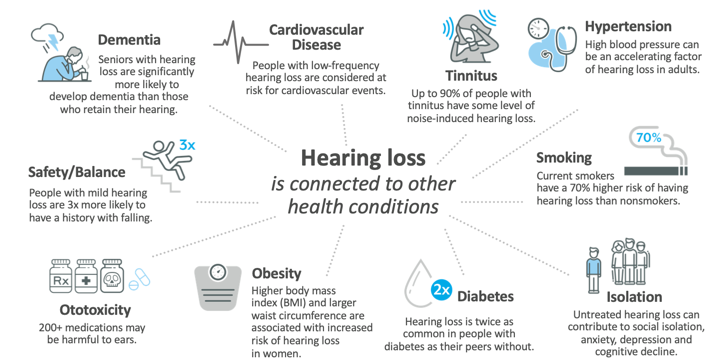
Figure 1. Associated connections of hearing loss.
The age of an average first-time hearing aid user is still around 70 years old. On average, people are going to wait approximately 4.5 years until they have that initial professional hearing evaluation. After they have that first assessment, we're seeing it's going to take seven to 10 years before any action is taking. Only one in four adults, less than 30% of people who are ages 70 and older, who could benefit from hearing aids, have ever used a hearing aid. We know that there are so many people that need help with hearing. Did you know that hearing loss is the number one service-related injury, and it's the third most prevalent chronic condition in the entire world?
I want to take a step back, before we get into the technology, and say that it all begins with caring. If we genuinely care for our patients, it shows. I'm sure you can remember a time when you were dealing with someone who didn't care. It's usually very evident from their body language and their attitude. I want to ask you now, do you care about your patient's hearing? And I'm sure you're all sitting there saying well, of course, I care about my patient's hearing. Yes, that's why I'm in this field. That's why I'm in this profession. Now I want to take it a step farther and say, well do you care about your patient's overall health? I'm sure your gut reaction is also once again to say yes. But where are your conversations going when your patients are in your office? Are they stopping after the discussion of hearing aids and connectivity to traditional hearing aid accessories? Or are you going one step farther and offering your patient something they can't get anywhere else? And this is where Livio AI comes in. It's time to reinvent the hearing aid. We need to create a multipurpose device that people will want to wear and reduce the stigma associated with hearing aids and hearing loss. We want to offer devices that provide the best possible hearing, along with links to overall health, as well as well-being.
The Hearing Aid Reinvented: Livio AI
Livio AI has sparked the interest of major tech companies, and I do want to highlight a few. We are excited, at Starkey Hearing Technologies, to be named a 2019 Honoree at CES in the accessibility category. Livio AI has also been named a 2019 South by Southwest Interactive Innovations Award Finalist in the category of AI and Machine Learning. Just a little background about the South by Southwest award here. The South by Southwest Interactive Innovation Award recognizes the most exciting tech developments in the connected world. The category of AI and Machine Learning honors digital systems which can adapt to changing data, stimuli, circumstances, replicating learning, problem-solving, and cognition. That's the basis behind AI, and we'll talk about that in a little bit. I am super excited about the newest launch of our AI product line, and I can't wait to see what additional honors we might receive. Figure 2 shows what was included in our first release of Livio AI back in August of 2018. This was the start of the revolution. You see, reinventing the hearing aid, it takes time, it takes effort, and it certainly doesn't happen overnight.

Figure 2. Livio AI products and accessories.
Figure 3 shows two graphs that look drastically different. On the left shows worldwide smartphone sales and, on the right, shows global hearing aid sales. We're looking at millions of units in both of these graphs but look at the scale difference. At the very bottom of the scale, we see 20 million units for hearing aid sales. At the very bottom of smartphone sales, we see 200 million units. If we were to make these scales equal, these graphs would be even more outrageously different. What I want to point out is why is it the case that we're in such a flat market when hearing loss is the third most prevalent chronic condition in the world? It's the number one service-related issue for our veterans. We are in the age of an ultimate multi-purpose device, the smartphone. I'm sure each of you has one, maybe even more than one. We need to make the hearing aid like the smartphone, a desirable device that works at the best hearing aid possible and also provides multiple functions that our patients want.
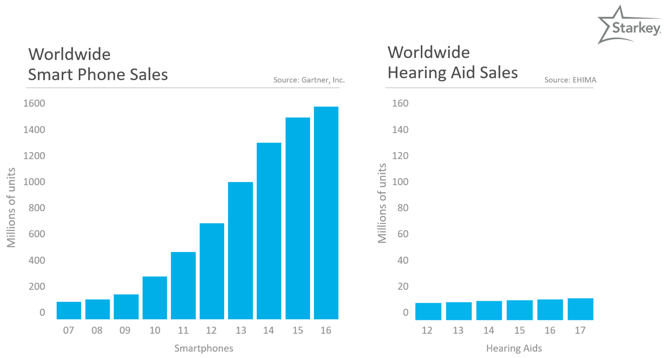
Figure 3. Worldwide smartphone and hearing aid sales.
World's First Healthable Hearing Platform: Thrive
Livio AI and Livio connect simply to a modern smartphone. They'll link to your TV and a media device like an Amazon Echo. You can stream phone calls, music, and more. Thrive is our new dual radio wireless connectivity platform. It's going to provide patients with critical binaural features, as well as universal Bluetooth connectivity to our line of Bluetooth accessories that we'll review. These patient-focused accessories are easy to pair and easy to use. They provide supreme sound quality. Throughout every step of the product design process, we look to improve the overall patient experience as a top priority at Starkey. I'm also excited to tell you that Livio and Livio AI are available in a RIC lithium-ion rechargeable, and also available with a Turbo Charger.
Dual Radio. Now we know that the ear is the ultimate location for accurate fitness tracking. Livio AI is a revolutionary multipurpose device that provides superior sound quality and the ability for users to accurately track their physical, as well as their cognitive health. We're calling it our Healthable hearing technology. Now Livio AI and the new Thrive platform incorporate a dual radio technology. The dual radio technology utilizes two radios, NFMI, and 2.4 GHz.
NFMI. NFMI is a highly-reliable signal over short distances. Think 20 centimeters, so around the head, if you will. It's going to allow us to have direct ear-to-ear communication and ear-to-ear phone streaming, as well as binaural environmental detection and coordination of signal processing.
2.4 GHz. Bluetooth is going to perform the best within the line of sight. This radio gives us direct conductivity to phones, as well as our accessories. It's going to provide high-speed data transmission while maintaining low power consumption.
Inertial Sensor. Next, let's talk a little bit here about the specific sensors that are embedded directly into the hearing aid. Livio AI is the world's only Healthable hearing technology with embedded inertial sensors. We have both an accelerometer as well as a gyroscope directly in the hearing aids themselves. This will allow the device to gather data independent of a smartphone or another accessory. As exciting as this technology is, it's important to remember that this is a hearing aid, first and foremost. So I'm excited to share that these are our best-sounding and best-performing hearing aids ever. Our number one goal has to be that this is the best-sounding and best-performing hearing aid. On top of all that, all of those AI features are great, but at the very core of the technology, we wanted to ensure that the sound of the hearing aid was superior from previous generations.
Livio and Livio AI Features
Spatial Speech Enhancement
Hearing Reality featuring Spatial Speech Enhancement is called Speech and Loud Noise on your Sound Manager screen. This feature is not new to Livio and Livio AI. It is a nice feature to round out our sound quality aspect of the hearing aid. Spatial Speech Enhancement is in Livio and Livio AI products, and it's only going to engage for loud noise inputs when it would provide the most benefit for the listener. What happens is the feature is going to stream the audio input from the right ear and stream it to the left ear and compare those signals. We're then going to stream audio information from the left ear and compare the signal with the right ear. This will reduce diffuse, meaning steady-state, background noise, as well as dynamic background noise, meaning speech babble. That's the hardest thing for hearing aids to do is to determine the speech source, and then what's just speech babble in the background. Our goal here is to reduce interfering sounds when they originate from the sides of the hearing aid wearer. Starkey wants to preserve speech and other sounds originating from in front of the wearer, presumably what they're looking at. By doing this as a binaural noise management strategy, Starkey preserves the interaural level differences. Thus preserving sound localization cues.
I am excited to share an independent study done by Delta Sense Lab back in November of 2018. The whitepaper is coming out soon. Delta SenceLab compared patient preference for hearing aid sound quality when in background noise. Now listeners were asked to compare the sound quality of various manufacturers, shown in Figure 4. The study looked at their high-end technology with their premier noise management features active. Results showed a significant preference for Starkey's Livio AI when listening in background noise. The study showed that Starkey's Livio AI provided a quieter, more comfortable listening experience when in that background noise.
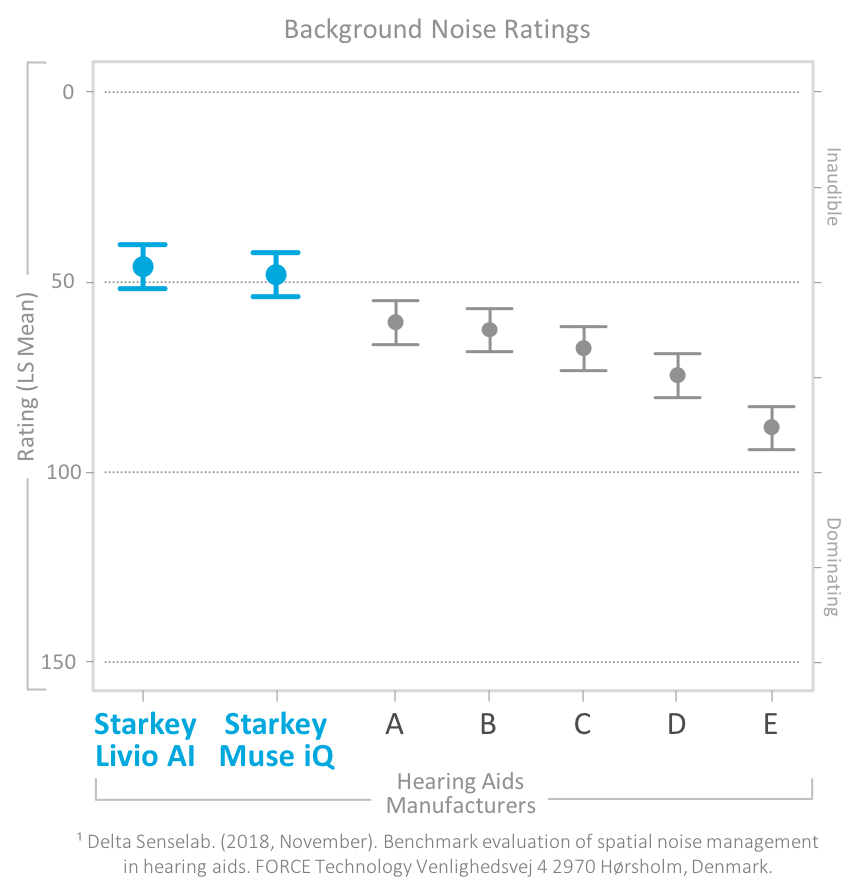
Figure 4. Sound quality of various manufacturers.
Comfort and Personalization Redefined
There are three features, one new and two updated. I want to review the second generation of Livio AI and Livio. On the updated Thrive platform, we're bringing amazing improvements to signal processing.
Feedback Canceller. First, let's talk about Feedback Canceller. There are two updates to our adaptive feedback cancellation strategy. These features are designed to improve the experience with amplification for both hearing aid users, as well as professionals. The personalized feedback sensitivity settings are automatically going to apply the ideal feedback sensitivity for each memory environment to eliminate unwanted artifacts. These are things like the warble you might have heard or a chirp that the listener might have experienced. The adaptive high-sensitivity option will no longer be the automatic default in most memory environments because this aggressive feedback cancellation is usually not necessary for a vast majority of patients.
Another thing we're implementing is a feedback-free start. This is going to provide an automatic gain reduction in channels where stable gain margins indicate the likelihood for feedback. This needs to be done following feedback initialization, that we always recommend you run in the patient's ear.
Output Compression Limiting. Next is our improved output compression limiting. Now, this is something that happens behind the scenes, if you will, but it's going to provide two benefits. It's going to deliver a richer, fuller, more natural sound quality for all input signals, meaning speech, as well as music. It's also going to allow for more gain of broadband signals. This will benefit those patients who want a greater perception of loudness from their hearing aids.
Transient Noise Reduction. Last but not least is our brand-new Transient Noise Reduction system. Our Transient Noise Reduction is a fast-acting noise reduction algorithm, designed to attenuate sudden loud sounds quickly. Think of a door slamming or dishes clanking together, and we want to make sure that we don't distort other important environmental or speech sounds, to deliver a more natural, less harsh sound quality. It's a wonderful addition to our suite of noise management features that provide the best comfort and sound quality in all environments. This new Transient Noise Reduction will appear as Transience in the Inspire fitting software.
New Features
Next, let's get into what it takes for Livio AI to become not only the best-sounding hearing aid but what we're doing from a manufacturing standpoint to transform it into a multipurpose device. With the original Livio AI introduction, Starkey offered the only hearing aid with the integrated body and brain tracking, live language translation, and our unique user control, which is a tap gesture. With the second generation of Livio AI, we have six new and exciting things to talk about shown in Figure 5. We will briefly cover heart rate measurements, which is coming soon and has not been officially released. We will have available the Thrive Assistant, directly from the Thrive mobile hearing control app. Self Check built right into the hearing aids themselves to be able to check the performance of the hearing aid. The provider can do this in the Inspire fitting software, and the patient has the ability from the Thrive mobile app to perform a self-check. Fall Detection and Alert System, this is a first to world that I'm excited to talk to you about. Voice-to-Text transcription. Last but not least, we'll touch on the rechargeable options that we have available for you, and get into some of the details when talking about rechargeable.
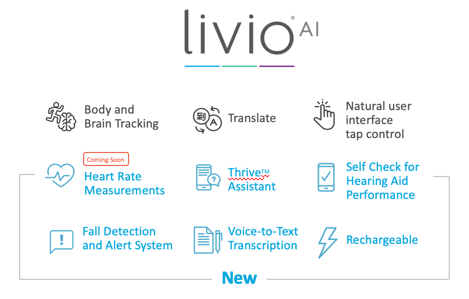
Figure 5. New features of Livio AI.
Sensors and Artificial Intelligence
Thrive Mobile App
Let's review the Livio AI Healthable features. First, we're going to discuss the brain and body tracking. Livio AI allows you to help patients of all ages take a proactive approach to their overall wellness. With motion sensors to detect movement, activity, gestures, falls, all integrated into each hearing aid. This information gives your patients access to feedback about their overall body fitness, as well as their mental fitness. Users can easily view and manage their health information with the Thrive Hearing Control app and receive daily feedback and progress by viewing their Thrive Wellness Score. This fully featured user-friendly app allows patients also to see activity progress, via the Body Score. With the Brain Score, they're going to see the benefits of wearing their hearing aids on a day-to-day basis.
Body Score
When you care about a patient's overall health and well-being, it's essential to understand why incorporating activity tracking into a hearing aid can be beneficial. Let's take a look at the details of the Body Score. There are numerous benefits to getting up and moving. A Kaiser study saw that walking for 30 minutes a day, five days a week has some outstanding reduced risk for several different conditions here. With Livio AI, the patient can monitor their activity without the need for additional devices. We're looking for the activity, meaning a brisk walk, a little faster than your average pace. Then your Move goal, a continuous movement for at least one minute per hour for 12 hours a day will get you all the points here for the Move goal. Your daily score can all add up to a total of 100. We do recommend that you leave the app open and running in the background. This will allow for the data transfer to happen more quickly between your hearing aids and your phone All of that activity that occurred within the hearing aids will transfer down to your phone once you open up the app. It might just take a second, as compared to if you had the app open and running in the background.
Brain Score
We know that health isn't just about staying physically fit, but also mentally fit. Research is showing that hearing aids have the potential to provide cognitive benefits. Starkey wants to provide a mechanism and tool for our patients to track that in the hearing aids themselves. The Brain Score is going to help the user monitor their mental stimulation via their auditory input. We see more and more studies coming out showing the link between hearing loss and dementia and cognitive decline. Studies show how wearing hearing aids can slow this decline. It's been shown that social interaction is the number one thing that can slow cognitive decline and dementia. Because of the critical connection between cognitive health and hearing health, Livio AI measures the brain benefits of wearing hearing aids. The Brain Score metrics include hours of daily use, and we want our patients to wear their hearing aids for 12 hours a day. This is where we're using the AI of the hearing aid and looking at the acoustic classifier of our noise management system to see the different types of environments, and assessing and awarding points based on the acoustic classifier in the hearing aid themselves. You can also get 100 points here for your Brain Score.
Thrive Wellness Score. When we add the Body Score max of 100 and the Brain Score max of 100, you see a maximum possible for the day is going to be 200 points. This is considered your Thrive Wellness Score. Let's dive into this high-level overview of the new features of Livio AI.
Fall Detection and Alerts
Livio AI is the world's first and only hearing device with fall detection and alerts. This feature provides peace of mind for both the user and their loved ones. When looking at falls and all of these statistics, the statistics speak for themselves. Every 11 seconds, an older adult is seen in the emergency department for a fall-related injury. We understand that people with just a mild hearing loss are three times more likely to have a history of falling. The research identified a 1.4-fold increase of incidents for falls for every 10 dB of measured hearing loss. So you're more likely to fall if your hearing loss is poorer than your peers.
The process for sending and receiving fall alerts is simple and effective. The hearing aid detected a fall. The patient can then cancel the alert within 60 seconds or send it out. The loved one who has already opted into the fall alert system receives a text message. When they open that text message, as long as they have location services active, they will see where the patient who fell, what their GPS location is. It will even give them the quickest route from where they are to be able to reach that patient. Now if the patient's okay, they can cancel the alert right within 60 seconds. If not, the indicators within the Livio AI hearing aids are letting the hearing aid user know that the alerts have been sent. They get an audible indicator in the hearing aids, which is nice.
Giving Patients More Control
At Starkey, we are reimagining what a hearing aid can do. Imagine that a hearing aid can increase accessibility for patients with either mobility, dexterity, or visual difficulties by providing features that can enhance their lives. Going beyond just the best-sounding hearing aid. If your patient doesn't have the visual acuity, manual dexterity, or fingertip sensation, they once did this can be a challenge. Then layer all of these issues on top of the cognitive ability for older adults to be able to manage a hearing aid. So that's why we are excited to be the world's first hearing aid to provide this natural user interface, our tap control, Translate future, Thrive Assistant, and Voice-to-Text Transcription.
Tap control. The natural user interface or tap control, if you will. The patient is going to reach up and double tap his hearing aid. He's touching his ear, that will double tap his hearing aid. Let's say he is watching TV and he's going to either stop or start that accessory stream (TV streamer or remote microphone plus). Remember the patient doesn't have to reach up and feel for the user control, even though it's a nice rocker switch in this case. They can double tap the hearing aid, they get an audible indicator, and then the streaming from that accessory will stop and start.
Thrive Assistant. This is an app-based assistant that can answer questions like "what's the weather today?" or "how do I create a custom memory?". The tap adjuster is available just on Livio AI devices because of the sensor. This Thrive Assistant is available for Livio AI, as well as Livio 2400 devices.
Translate feature. This is an integrated feature that helps patients easily communicate with people who speak other languages via an easy-to-use translation tool in the Thrive app. I'm also excited to tell you that this is not only available for our iPhone users, but this is also available for your Android users when streaming through the Remote Mic +. You don't have to have a hearing loss to use this feature, this can be used for even normal-hearing people who need some help with live-time translation.
Voice-To-Text Transcription. Think closed captioning for the real world. The conversation is going to be transcribed so the user can see it on their smartphone screen. Then they can save, send a message, copy and email the transcribed text. There are many ways that you can use this voice-to-text transcription. Whatever is said into the microphone of the iPhone is going to be transcribed right onto the patient's screen. Very easy to use.
Heart Rate. Now we can't leave out one of the newest features that is not yet available, but coming soon, will be our custom heart rate monitors. There is an optical heart rate sensor in the custom mold. When you think custom mold and you think AP Receiver, you maybe think 70 Gain Receiver. Rest assured that this is available in all of the receiver strengths that Starkey has available, so it's not just for those power users. We see that people with low-frequency hearing loss are considered for even higher risk of cardiovascular events. This could be beneficial. This is an on-demand measurement, and the patient can also measure their heart rate recovery. The heart rate recovery feature is common in athletes to see how quickly does my heart rate get back to that normal resting rate. Then that number can correspond to a biological age that you could then compare to a chronological age to see if your body is acting as young as you physically are. So coming soon, this Custom Healthable Receiver and of course, we'll have an entire course on our Healthable Technology.
Universal Bluetooth Connectivity with Patient-Focused Accessories
I want to take a look at our 2.4 GHz accessory lineup.
Mini Remote Microphone. The newest is the Mini Remote Microphone, and it is straightforward and easy to use. This accessory provides excellent sound quality for any individual that needs a simple remote microphone solution. It can also be used to stream audio from television when placed near the external speakers of a TV.
Remote Microphone +. This is a multipurpose, easy-to-use remote microphone that will allow patients to stream audio and phone calls from their smartphones like Android — allowing them to be able to get that directly into their ears. It also has a telecoil in it and a loop system, as well as an analog in, for those devices that maybe don't have Bluetooth that they want to stream from, like my super old iPod that's got all my music on. I could plug that into my Remote Microphone + and stream directly to my Livio, Livio AI hearing aids.
TV streamer. The TV streamer is going to stream audio from your television or other sources directly into your Livio AI, and Livio hearing aids. It's got excellent sound quality, it's easy to use, and it will support both analog as well as a digital input. The beautiful thing about Starkey's TV streamer is that you can pair, technically, an unlimited amount of hearing aids to the one TV streamer itself. So if you have a husband and wife who both have Livio or Livio AI devices, they could both use this one TV streamer. It's not a one-to-one connection, which is excellent.
Remote Control. This is going to allow patients to control memory and volume functions, as well as adjusting the streaming volume or mute the hearing aids if they wanted to.
Starkey has worked to make streaming quality a priority when designing Livio AI, and I'd like to share just a small internal study that we conducted. We would ask the participant to listen to each of the hearing aids and listen to a phone call stream and say which one sounded the best. We did the same thing for music, asking which music sample sounded the best. You will see that Livio AI was ranked number one most often for phone call streaming, as well as music streaming.
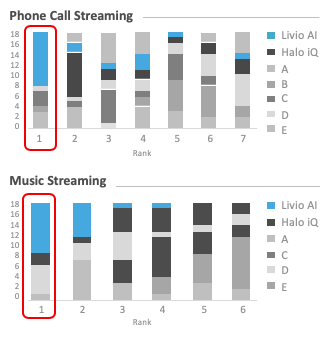
Figure 6. Streaming rankings.
Hearing Care Anywhere
Now when we talk about Hearing Care Anywhere, this is Starkey's telehealth remote hearing aid programming system. We want to bring convenience to both patients and professionals. And we want to give them unique services that they can't get anywhere else.
Remote Programming
This is where remote programming can be beneficial. So patients can request fine-tuning adjustments to help with their experience here. So let's see, here we go. So we want our professionals to provide value to these added services. We want Hearing Care Anywhere to be a tool that people aren't shying away from but is widely accepted. And I'll tell you that it's a great tool. So imagine the patient who comes in, and you know, maybe it takes them a train ride and a taxi and a bus ride and all of these modes of transportation to get to your office. This can help for just those small fine-tuning adjustments to be able to do them directly from the office while the patient's still at their home. I also think of remote programming as, you know, I've seen this patient two or three times now, and we're trying to adjust their restaurant memory, and we're just not getting it right. The nice thing about Hearing Care Anywhere and our remote programming system is the patient can listen to the changes while they're in that environment. Right, so while they're at that restaurant, they can say, okay did this make it better, did it not make it better, and then they can request an additional help request from there. There, of course, is an entire course on remote programming. If it's something you're interested in, I encourage you to take that course.
Self Check
Now Self Check, if anyone remembers Self Check from several releases ago, know that this Self Check, although it has the same name, is entirely different. So it is a quick, convenient way for patients to analyze the hearing aid system performance. What needs to happen is the provider is going to set a baseline measure within the Inspire fitting software. Once the provider sets that baseline measure, it's checking the receiver, the microphone, the hearing aid circuit, and then if the patient has the heart rate sensor earmold, it's also going to check those components. Once the provider sets the baseline in the Inspire fitting software, the patient themselves can run a diagnostic check from their Thrive mobile app to say, something's not sounding right, I've changed the wax guard, or I don't know how to change the wax guard, let me see what's going on with my system here, they can run a diagnostic check from the Thrive app. The provider can also run a diagnostic check when the patient's in the office. So maybe they've changed their receiver, they've changed the microphone, and something isn't sounding right. Perhaps it needs to go in for repair, and they would get a notification that maybe the circuit wasn't running up to specs, for example. So the Self Check feature is available on all levels of technology for all Livio, Livio AI devices, which I think is a nice addition to this product lineup.
Rechargeable - Smart, Convenient, Reliable
I am excited to share that Starkey has added a rechargeable RIC to the product lineup. The RIC rechargeable is a lithium-ion product which is also CROS compatible and will ship with the All-in-One Charger. This charger is different than the Synergy Charger that was shipped with Muse iQ. Starkey also has available the Mini Turbo Charger.
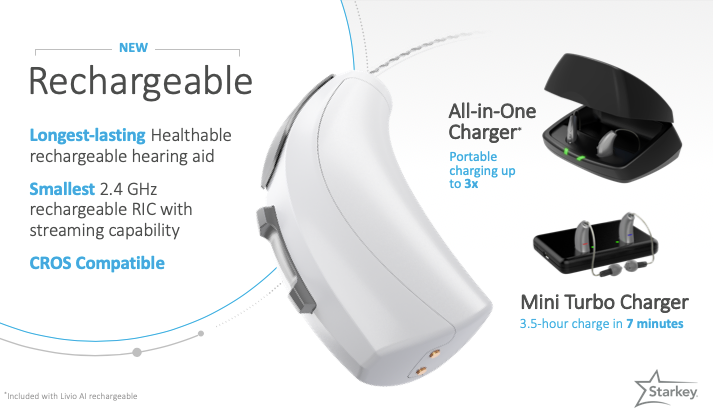
Figure 7. RIC rechargeable, All-in-One Charger, and Mini Turbo Charger.
The new RIC R uses a lithium-ion battery and is available in Livio AI with the Healthable Technology. Also available is the Livio Hearing Aid, available in five different levels of technology. You'll see in Figure 8, Dual Radio with 2.4 GHz and NFMI, meaning it's CROS System-compatible, so a rechargeable CROS option. The CROS System is available in the top three tiers of technology, so not compatible with the 1200 or 1000. We are sticking with Wireless Programming only, and, of course, compatible with our 2.4 GHz Starkey Hearing Technologies Accessories. It has a telecoil, which I'm excited about.
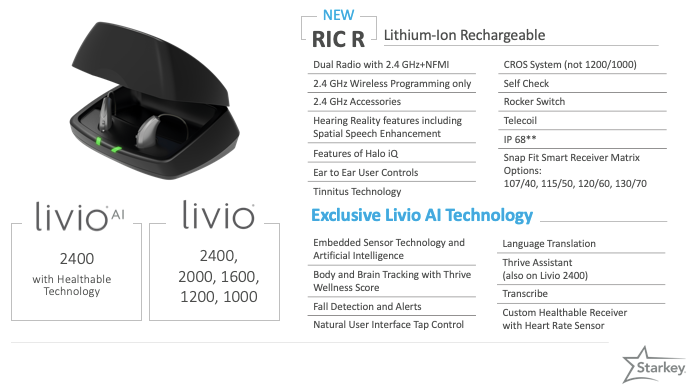
Figure 8. Livio AI and Livio rechargeable products.
Battery
If the battery is fully charged, we include one hour of streaming time and 24 hours of battery life. These estimations are for a 50 Gain Receiver. When we look at 60 and 70 Gain Receivers, these numbers aren't exact, but your patient will still get an entire day and then some of battery life.
We still have the traditional charger. The hearing aids will still turn themselves off when you place them in the charger and automatically turn themselves on when you take them out. That has not changed, which is a nice feature for those patients who have reduced dexterity.
Mini Turbo Charger
Available as an additional option for your rechargeable patients is the Mini Turbo Charger. Starkey released this product a little while ago, but I do want just to do a quick review of it. I think the Mini Turbo Charger is going to be great for your CROS patients who are streaming the entire time. In 7 minutes, a turbo charge provides 3.5 hours of hearing aid use. This product is compatible with Livio AI, Livio, and backward-compatible with the Muse iQ RIC R, for those patients who need a small charger without the desiccant pocket.
Review of Products
Micro RIC 312
The Micro RIC 312 is available in Livio AI with Healthable Technology and also in Livio. The Micro RIC is small and has one radio. So we have 2.4 GHz, there's Bluetooth in the hearing aid. There is not the NFMI in the hearing aid. The most important thing that I see with the lack of an NFMI radio is that the Micro RIC is not CROS compatible, for those CROS patients. But it still has our great Hearing Reality features, Ear to Ear User Controls, Self Check and a push button. Your battery life is pretty solid, four to seven days for this Micro RIC 312.
Exclusive Livio AI Technology. Just as a brief reminder, what's included with AI is the Healthable Technology: Brain and Body Tracking, double tap control, Language Translation in the Thrive app, Fall Detection and Alert system, and then Thrive Assistant and Transcribe.
RIC 312
The RIC 312 has a Rocker Switch and available with Healthable Technology in five levels of technology. This product utilizes a Dual Radio with 2.4 GHz and NFMI. The hearing aid is connected via Wireless Programming only. The battery life lasts four to seven days and is CROS System-compatible.
BTE 13
Still available is the BTE 13 which is now in five levels of technology with the Telecoil and Rocker Switch. Same technology as before for those patients who need that power.
Livio AI/Livio CROS System
If you're unfamiliar with CROS, the transmitter we're utilizing as a universal transmitter, universal to Starkey, meaning that it's tier agnostic. So you're not going to order a level of technology, per se, for your transmitter. You're only going to fit the receiver at the level of technology. The sensor technology is disabled on the transmitter, but it is still available on the receiver. The Custom Heart Rate Sensor will be unavailable if you're fitting that RIC R with the Custom Heart Rate Sensor coming soon. That will not be available on the transmitter, that is just available on the receiver.
If my patient had a BiCROS memory, they could come in and adjust the microphone sensitivity to say I want a little more emphasis from the receiver or I want a little more emphasis from the transmitter. They can also, directly from their app, mute the transmitter, how great is that.
Summary
I hope that you have found this overview to be helpful. You'll see that we have a full lineup of products for you. We genuinely believe that if your patients hear better, they will live a better life. I do want to leave you with our additional course offerings which are available here. I hope you found this information useful.
Citation
Szarythe, A. (2019). Evolution of the hearing revolution. AudiologyOnline, Article 24441. Retrieved from https://www.audiologyonline.com


